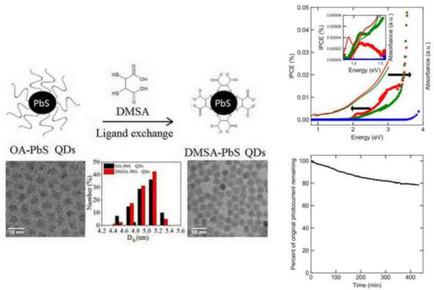当前位置:
X-MOL 学术
›
ChemNanoMat
›
论文详情
Our official English website, www.x-mol.net, welcomes your
feedback! (Note: you will need to create a separate account there.)
Sensitization of SnO2 Single Crystals with Multidentate‐Ligand‐Capped PbS Colloid Quantum Dots to Enhance the Photocurrent Stability
ChemNanoMat ( IF 2.6 ) Pub Date : 2020-02-03 , DOI: 10.1002/cnma.201900679 Guobao Li 1, 2 , Qian Yang 2 , Lenore Kubie 2 , Joshua T. Stecher 2 , Zbigniew Galazka 3 , Reinhard Uecker 3 , Bruce A. Parkinson 2
ChemNanoMat ( IF 2.6 ) Pub Date : 2020-02-03 , DOI: 10.1002/cnma.201900679 Guobao Li 1, 2 , Qian Yang 2 , Lenore Kubie 2 , Joshua T. Stecher 2 , Zbigniew Galazka 3 , Reinhard Uecker 3 , Bruce A. Parkinson 2
Affiliation

|
A PbS quantum dot (QD) sensitized SnO2 solar cell has the advantage of producing photocurrent from near‐infrared to the ultraviolet that covers much of the higher energy solar spectrum. However, the long‐chain ligands, that are frequently used to cap as‐synthesized QDs, inhibit the charge transfer ability to the sensitized substrate, decreasing the photovoltaic efficiency in the device. Herein, we present a fast and efficient ligand‐exchange strategy for the replacement of synthetically convenient hydrophobic oleic acid (OA) ligands with short‐chain multidentate hydrophilic ligands such as meso‐2,3‐dimercaptosuccinic acid (DMSA) that increase the electronic coupling to the SnO2 substrate. Results from ultraviolet‐visible‐near‐infrared (UV‐Vis‐NIR) spectroscopy, X‐ray diffraction (XRD) measurements, and high‐resolution transmission electron microscopy (HR‐TEM) micrographs verify that this ligand‐exchange method produces no significant QD size or crystal‐structure changes. X‐ray photon spectra (XPS) results suggest that thiol groups from DMSA are likely bound to the PbS QDs compared to other bifunctional ligands. The PbS QDs sensitized SnO2 single crystals were characterized with atomic force microscopy (AFM), and with incident photon current efficiency (IPCE) spectra. Furthermore, it was shown that the IPCE of DMSA‐capped PbS QDs sensitized SnO2 single crystals retains >80% of its initial value after >7 hours of illumination within an electrolyte containing a high concentration of NaI whereas other ligand capped PbS QDs degraded much more rapidly.
中文翻译:

具有多齿配位的PbS胶体量子点的SnO2单晶敏化,以增强光电流稳定性
PbS量子点(QD)敏化的SnO 2太阳能电池具有产生从近红外到紫外光的光电流的优势,该电流覆盖了许多较高能量的太阳光谱。但是,长链配体(通常用于封端合成的QD)会抑制电荷向敏化底物的转移能力,从而降低器件的光伏效率。本文中,我们提出了一种快速有效的配体交换策略,以短链多齿亲水性配体(如meso-2,3-二巯基琥珀酸(DMSA))替代合成方便的疏水性油酸(OA)配体,以增强电子耦合到SnO 2基质。紫外可见-近红外(UV-Vis-NIR)光谱,X射线衍射(XRD)测量和高分辨率透射电子显微镜(HR-TEM)显微照片的结果证明,这种配体交换方法不会产生显着影响QD尺寸或晶体结构发生变化。X射线光子光谱(XPS)结果表明,与其他双功能配体相比,DMSA中的硫醇基可能与PbS QD结合。用原子力显微镜(AFM)和入射光子电流效率(IPCE)光谱表征了PbS QDs敏化的SnO 2单晶。此外,研究表明,DMSA封端的PbS QD的IPCE增敏了SnO 2 在含有高浓度NaI的电解质中照射> 7小时后,单晶保留其初始值的> 80%,而其他配体封端的PbS QD降解更快。
更新日期:2020-02-03
中文翻译:

具有多齿配位的PbS胶体量子点的SnO2单晶敏化,以增强光电流稳定性
PbS量子点(QD)敏化的SnO 2太阳能电池具有产生从近红外到紫外光的光电流的优势,该电流覆盖了许多较高能量的太阳光谱。但是,长链配体(通常用于封端合成的QD)会抑制电荷向敏化底物的转移能力,从而降低器件的光伏效率。本文中,我们提出了一种快速有效的配体交换策略,以短链多齿亲水性配体(如meso-2,3-二巯基琥珀酸(DMSA))替代合成方便的疏水性油酸(OA)配体,以增强电子耦合到SnO 2基质。紫外可见-近红外(UV-Vis-NIR)光谱,X射线衍射(XRD)测量和高分辨率透射电子显微镜(HR-TEM)显微照片的结果证明,这种配体交换方法不会产生显着影响QD尺寸或晶体结构发生变化。X射线光子光谱(XPS)结果表明,与其他双功能配体相比,DMSA中的硫醇基可能与PbS QD结合。用原子力显微镜(AFM)和入射光子电流效率(IPCE)光谱表征了PbS QDs敏化的SnO 2单晶。此外,研究表明,DMSA封端的PbS QD的IPCE增敏了SnO 2 在含有高浓度NaI的电解质中照射> 7小时后,单晶保留其初始值的> 80%,而其他配体封端的PbS QD降解更快。











































 京公网安备 11010802027423号
京公网安备 11010802027423号